Shopify Exchange: How to Buy Your First Shopify Store
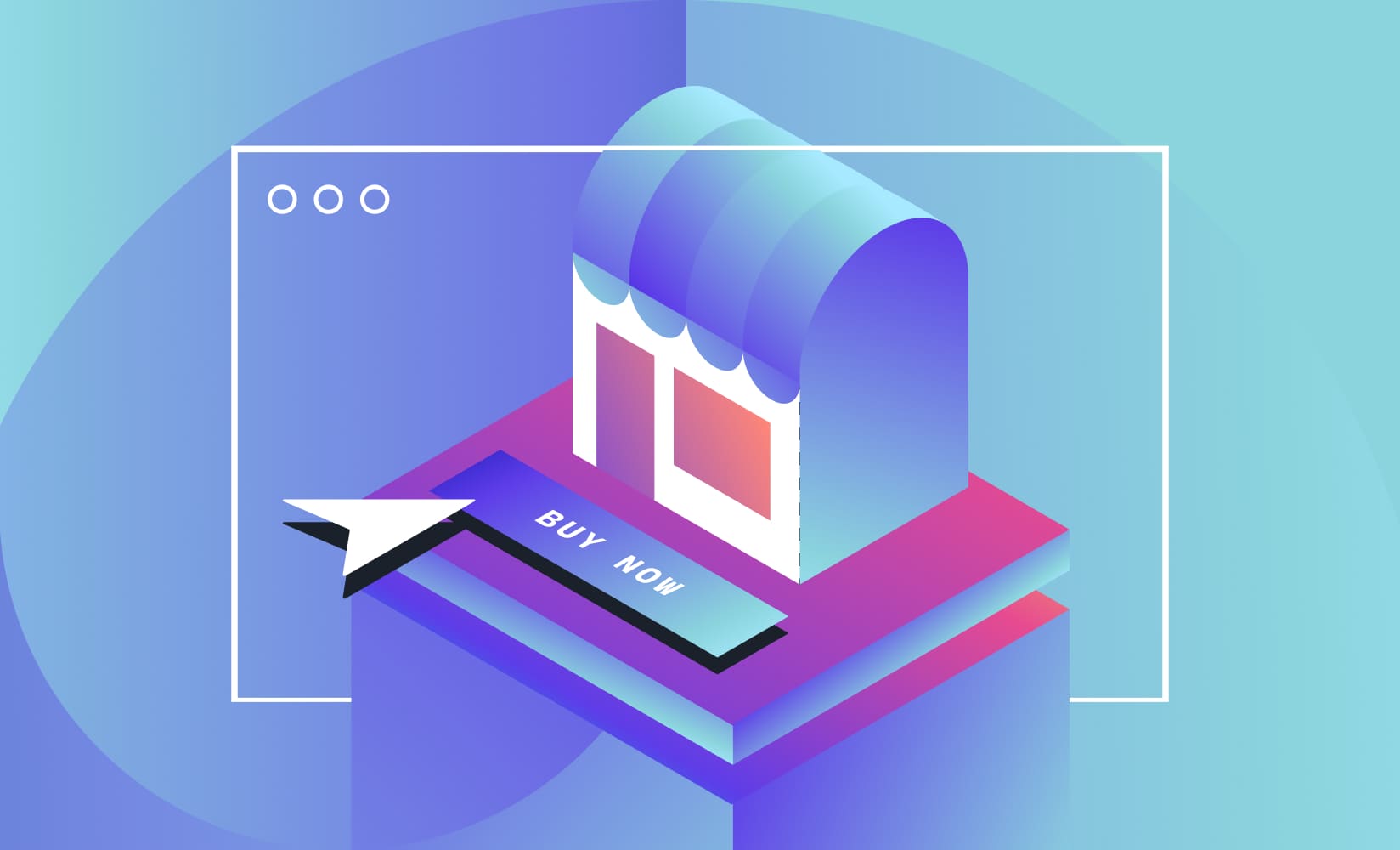
At Shogun, we’re frequently extolling the numerous virtues of starting your own Shopify store. And, for many, that’s just what they want to do, start something from scratch and watch it grow.
But, for others, they’d love to be able to start selling right away with a pre-made Shopify store, all ready for ecommerce action.
As with a used car, they want to be able to turn the key and start driving something that’s already shown promise on the road.
Luckily, you can do just that with Shopify Exchange.
Once you’ve kicked the tires and done your proper research, you can take a Shopify store home that can start earning right away.
In this post, we’ll cover:
- What Shopify Exchange is
- Reasons to buy or sell an online store
- Pros and cons of purchasing a Shopify store
- How to buy a store on Shopify Exchange
First thing, let’s get acquainted with Shopify’s online store marketplace.
#cta-visual-pb#<cta-title>Buy that Shopify store and customize it for sales<cta-title>Optimize your new readymade store for better conversions with the best page builder for Shopify.Start building for free
Shopify Exchange is a marketplace for buying and selling Shopify stores.
Shopify runs it, which ensures that the transactions are secure and the platform-based data is accurate.
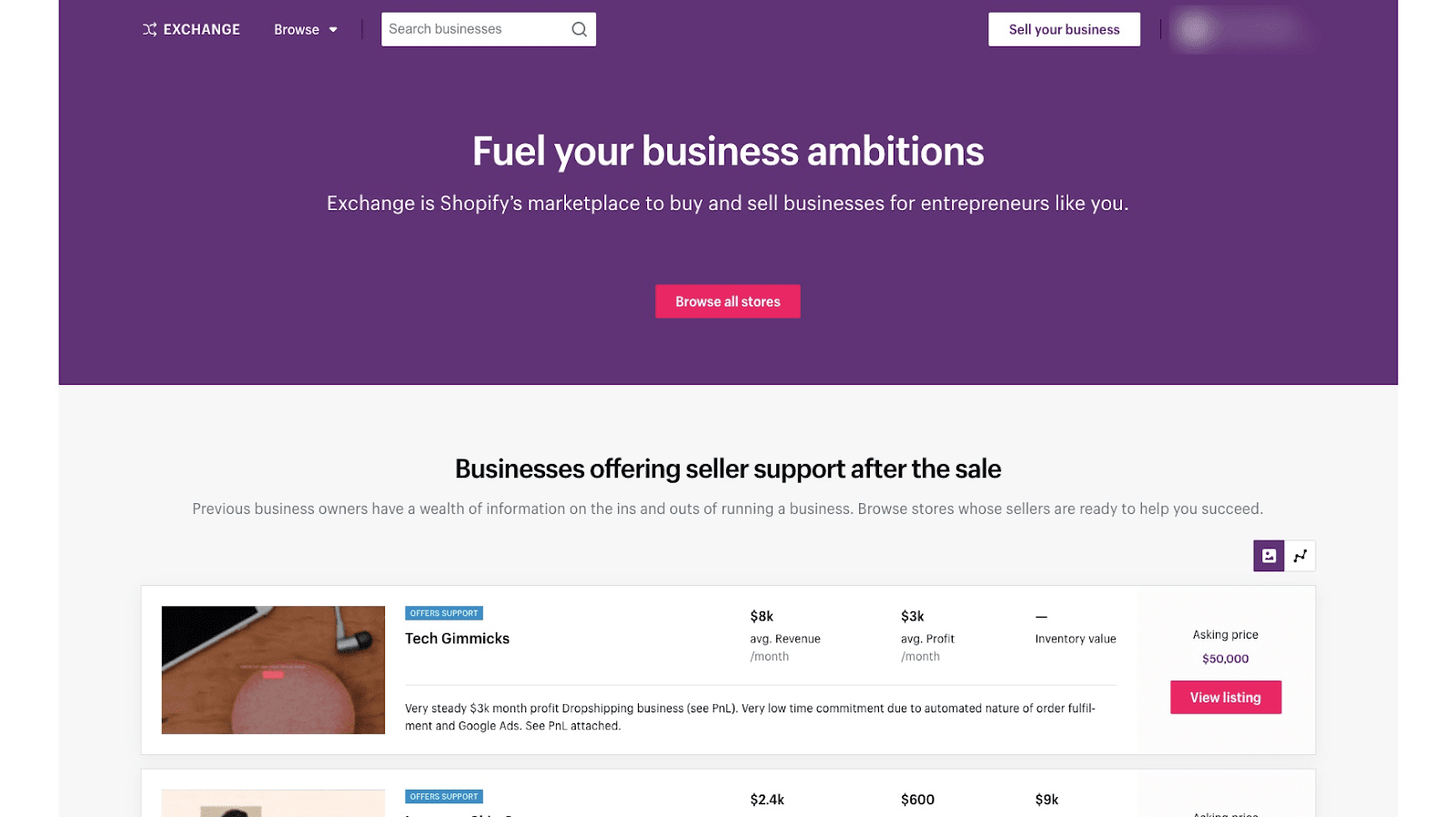
Those looking to buy an existing Shopify store can peruse the listings to learn:
- The story behind the business, like why they got started and why they are selling.
- Revenue and traffic data, independently verified by Shopify and uneditable by the seller.
- Business expenses for which the buyer will be responsible.
- What’s included with the sale, such as inventory, branding, support, social media, and more.
- Seller’s advice for growing the business and what the buyer should know going in.
There are many reasons you may want to buy an existing Shopify store, just as there are many reasons why someone would want to start from scratch.
Here are some reasons to buy an online store:
- The desire to hit the ground running. Tons of people just prefer having all the legwork done for them, so they can get to work on the day-to-day running of the business.
- Not interested in building a store from scratch. There are so many decisions to make when building a brand, let alone all the time it takes to create something brand new. Sometimes, you just want a readymade brand.
- Make money on day one. Starting from nothing means you have to wait a while to build an audience and start making money. Buying a store with an audience built-in means you can begin seeing revenue right away.
Why people sell their Shopify stores
People sell things they prize all the time. Some people love to build things only to sell them later.
Here are a few reasons why people sell their stores:
- They encounter major life changes. People may want to pursue new challenges or find themselves unable to keep up with running a store.
- The joy of building something valuable and selling it. Certain people enjoy creating an enterprise, selling it, and moving on to the next store. They are like house flippers, but for ecommerce stores.
- They no longer enjoy running a store. They tried it, and it wasn’t their thing. Luckily, they can sell it to someone excited about running a store.
- They need cash. Sometimes people just need to liquidate their assets for emergencies. Successful Shopify stores are great assets when you need them.
There will be sellers that want to get out of a sinking ship, which is why you need to do your research before buying.
Finding the right ecommerce store for you
When you go searching for a store to purchase, you likely already have the shape of it in your mind.
Shopify Exchange has helpfully split up stores into many categories, such as business type, industry, location, business size, and more.
One of the more consequential decisions you’ll make is what type of store you buy, as this will affect whether you keep inventory yourself and how fulfillment is managed.
Types of online stores available on Shopify Exchange
- Print on demand. These custom print businesses create their own designs and outsource printing and fulfillment to a third-party print-on-demand site. Choose the product types you want to add designs to and start selling.
- Dropshipping. No inventory required. These stores have relationships with wholesale vendors that will ship products worldwide.
- Retail stores. These businesses hold at least some inventory, manage the manufacture of products, and fulfill from their own warehouse.
- Established businesses. A little more mature, these stores have shown their lasting power and have a significant amount of revenue to show for it.
- Inventory. These stores have inventory included in the sale, ready to hand off for the continuation of business.
You can also look at recently sold stores to get a sense of what has been selling and at what cost before starting your own search.
There is an extensive range of prices for the listings, with a majority going for $500 or less and some going for over a million bucks. The value of any particular store is going to be in the details.
It’s always great to know the biggest benefits and disadvantages of any particular decision.
This is most definitely true when considering shelling out many thousands on a new job in ecommerce.
Pros
- Skip the work of building a store from scratch. As was mentioned already, not everyone feels like putting in the work to build a store from the ground up, with all the technical details, design work, and audience-building marketing. By buying a store, it’s already done, and you can get to work selling.
- Product popularity is already proven out. Many entrepreneurs have to wait and see if their product will catch on or trending down. With an existing store and product line, you can see how well it does with shoppers. They pass you the baton, and you keep the sales coming in.
- Start selling ASAP with an existing audience. One of the hardest things to do as you start a store from scratch is to build up an audience (and email list) primed to buy what you are selling. When you take over a store, you also get the customers that go with it, so you can remarket to keep them coming back and entice those on the verge of buying.
Cons
- Their reputation (good or bad) is now yours. Hopefully, this is something you’d catch in your company research, but you may miss it. Repairing a brand’s reputation will set you back in time and money, which would have been better put to use in growing a popular business.
- Unfamiliarity with customers and industry. Buying someone else’s business doesn’t mean you gain their savvy within the industry or an understanding of who they are selling to. Again, doing your research is key to getting into a business that you won’t feel unprepared to run.
OK, so now you are ready to buy your first Shopify store.
You have your budget, your general outline of the type of business you’d like, and a curious mind prepared to get into the weeds with research.
So, here are the steps you’ll take—from first search to final sale—to buy an ecommerce store from Shopify Exchange.
Step 1: Start by knowing what you want
Ecommerce is full of variety. Online retailers sell everything under the sun and do so in many ways.
You don’t want to start searching this marketplace without understanding what kind of store you want to own. And, you don’t want to buy a store with a product that will just flop in a few months.
So, you do some research. Grab a pen and paper as you begin sketching out your ideal ecommerce venture.
Inventory management and fulfillment
As was mentioned previously in this post, how you want to deal with product inventory and shipping is key to shopping for a store.
If you’d rather stay out of the warehousing and shipping side of things, you’ll be looking for a dropshipping or print-on-demand setup.
If you want to hold inventory and ship it yourself, look for shops with inventory value in the listing.
These distinctions will narrow down your search immensely right out of the gate. At this stage, just jot this down in your notebook and move on.
Find a popular niche
While some products are always popular (coffee, jeans, wolf-emblazoned fleece blankets), others can see their popularity rise and fall quickly.
Just as you’ll want to know how you’ll warehouse and ship your products, you’ll also want to know what those products will be.
Luckily, there are plentiful research tools to help you find what is trending and what is falling out of fashion. Beyond that, there are also helpful guides that lay out trending products for Shopify.
To start your research on trending products, you’ll want to look at free tools like Google Trends and Exploding Topics, as well as keyword research tools like SEMrush and Ahrefs.
Add all your findings to your handy notebook and keep it on hand when looking through the marketplace.
Step 2: Search Shopify Exchange for best fit stores
Now that you have an idea of what kind of store you want to buy, it’s time to start looking for it.
There are thousands of store listings, so you’ll want to utilize the filters to keep it simple.
You can either start from the Browse dropdown in the upper left corner or click Browse all stores in the header and use the filters.

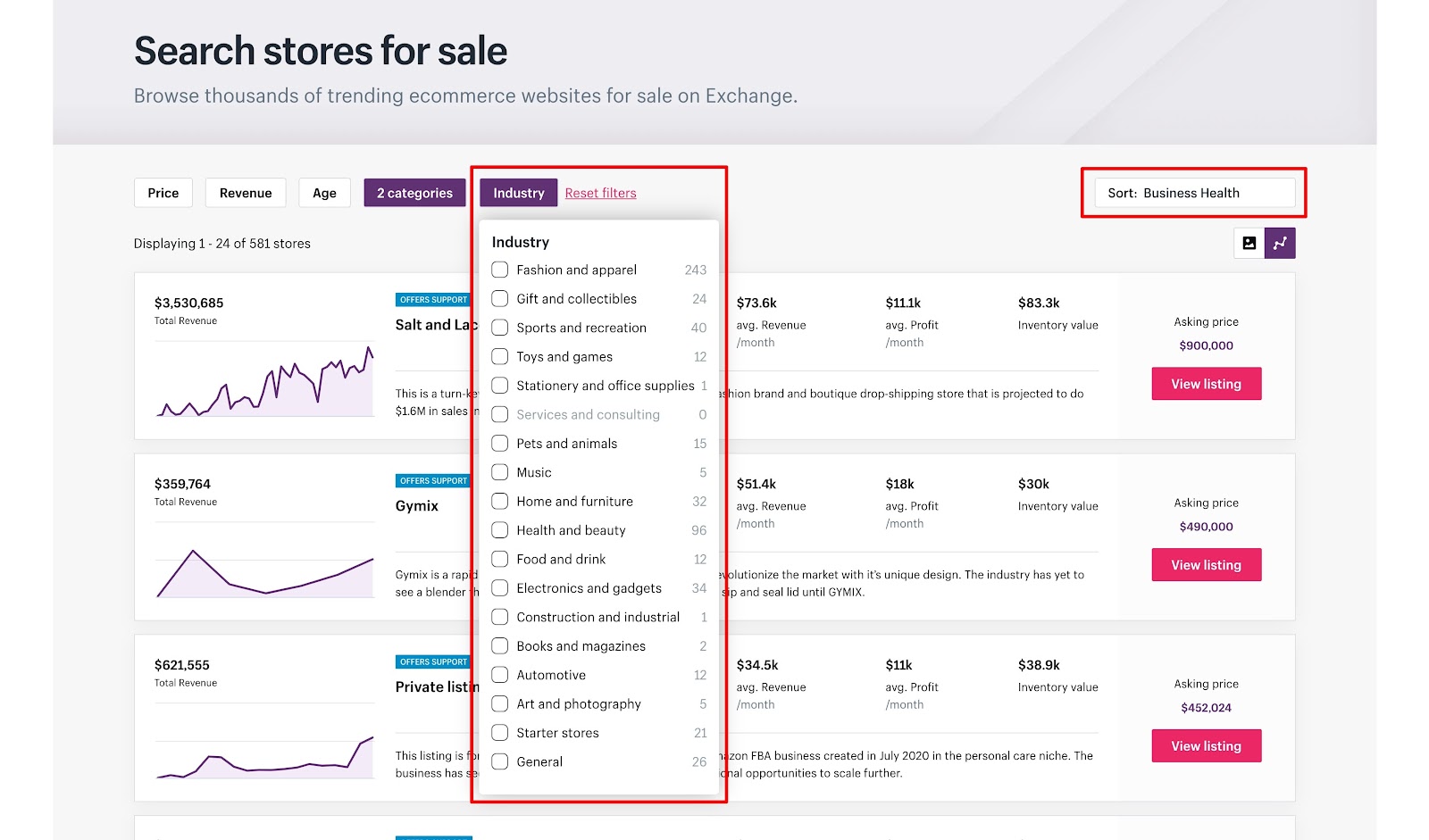
Filters you can use include:
- Price. Easily find only the stores in your budget.
- Revenue. Find only stores with your ideal monthly average revenue.
- Age. Stores that have been around longer will have more historical data to draw from, but they may be more expensive.
- Business type. Based on your inventory management and fulfillment needs, this filter will help you narrow down your search significantly.
- Industry. Look to your trending products research to find stores in your preferred niche market.
You can also sort your filtered results by Business Health, Revenue, Price, and Most Recent.
Look carefully through each store that fits the bill. Each listing will have the following sections.
Business Story
It’s essential to know the background of the businesses you hope to buy.
This section details why they started the business, why they are selling it, and what is involved in the day-to-day running of the business.
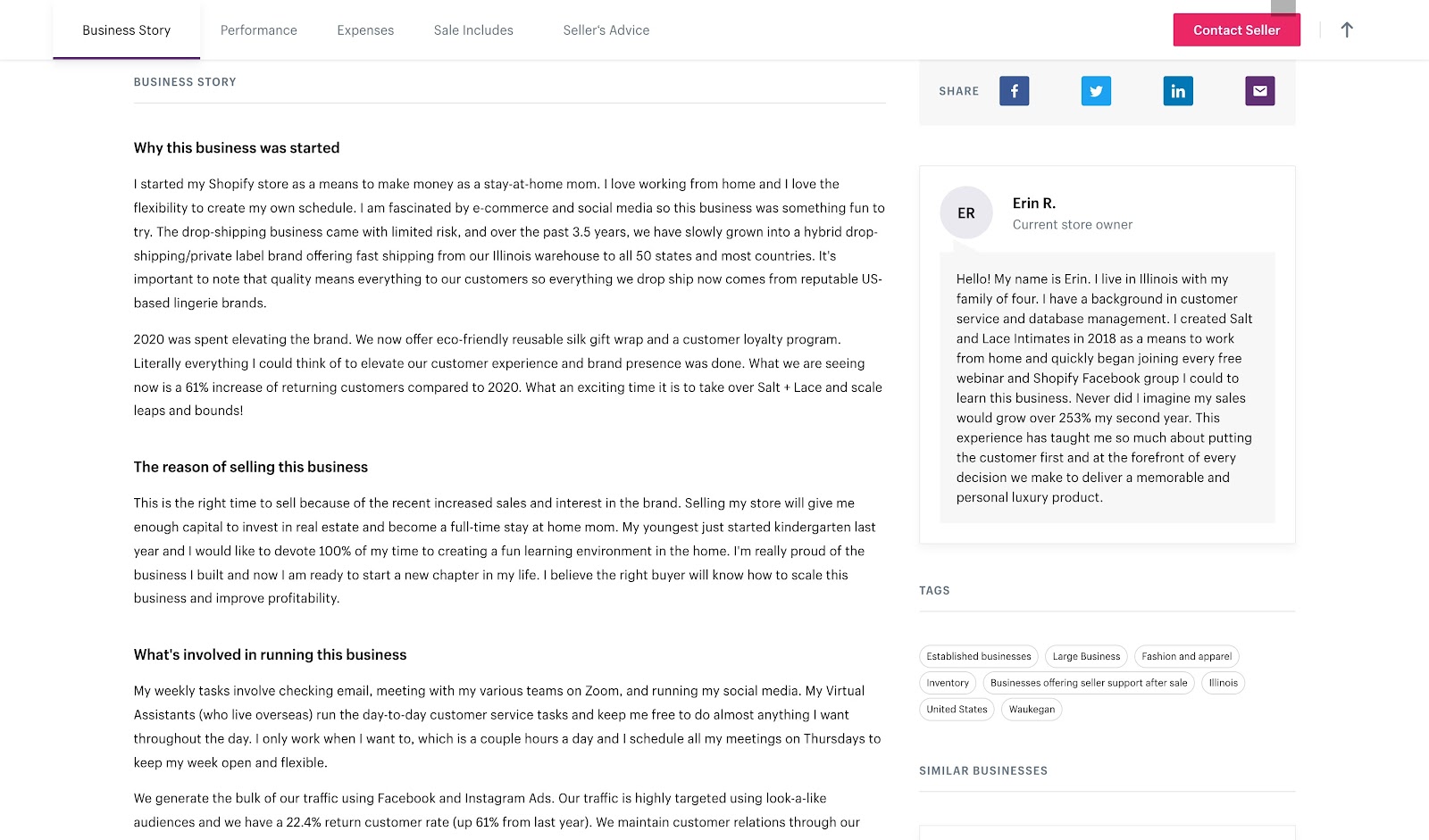
Performance
Knowing how well a business is performing and has historically performed will be central to the purchase decision you make.
Shopify helpfully ports verified revenue and traffic data to the marketplace, so you can trust that the seller didn’t fudge the numbers.
Here you’ll see average monthly revenue, average monthly traffic, average monthly profit, inventory value (if any), profit margin, and the number of sales per month.
Note: Shopify can’t verify profit margins. When you do your due diligence, you’ll want to confirm the details they’ve provided.
The seller can also add other details about profit that the data may not describe.

Expenses
Another critical piece of information here—all the money a store spends to keep things running.
This will give you a good idea of what you’ll be paying out once you own the store. Expenses vary by store but will include things like:
- Shopify plan
- Domain
- Third-party apps and services
- Paid advertising via Facebook, Google, and others
- Inventory
- Employees
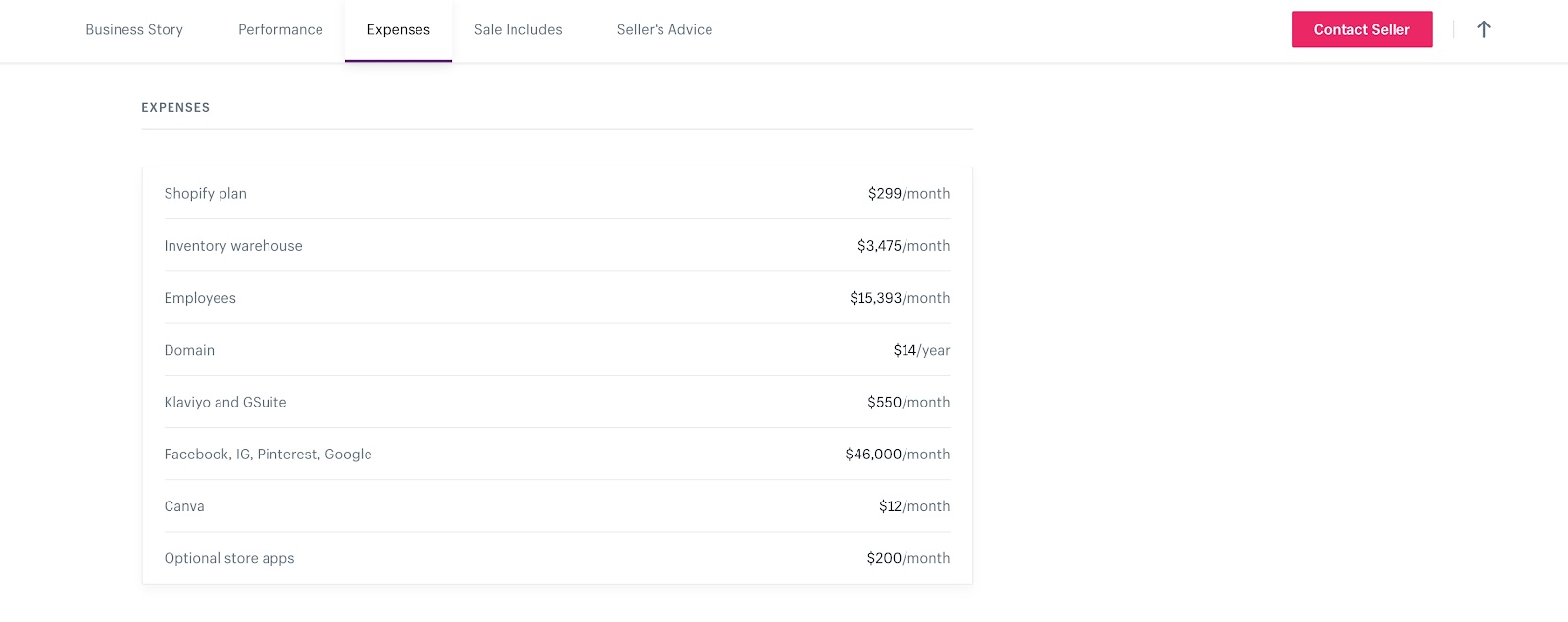
Sale Includes
This section details what comes with the sale price.
You know you’ll get a store, but you can also get a domain, marketing assets, social media accounts, email lists, inventory, supplier relationships, and more.
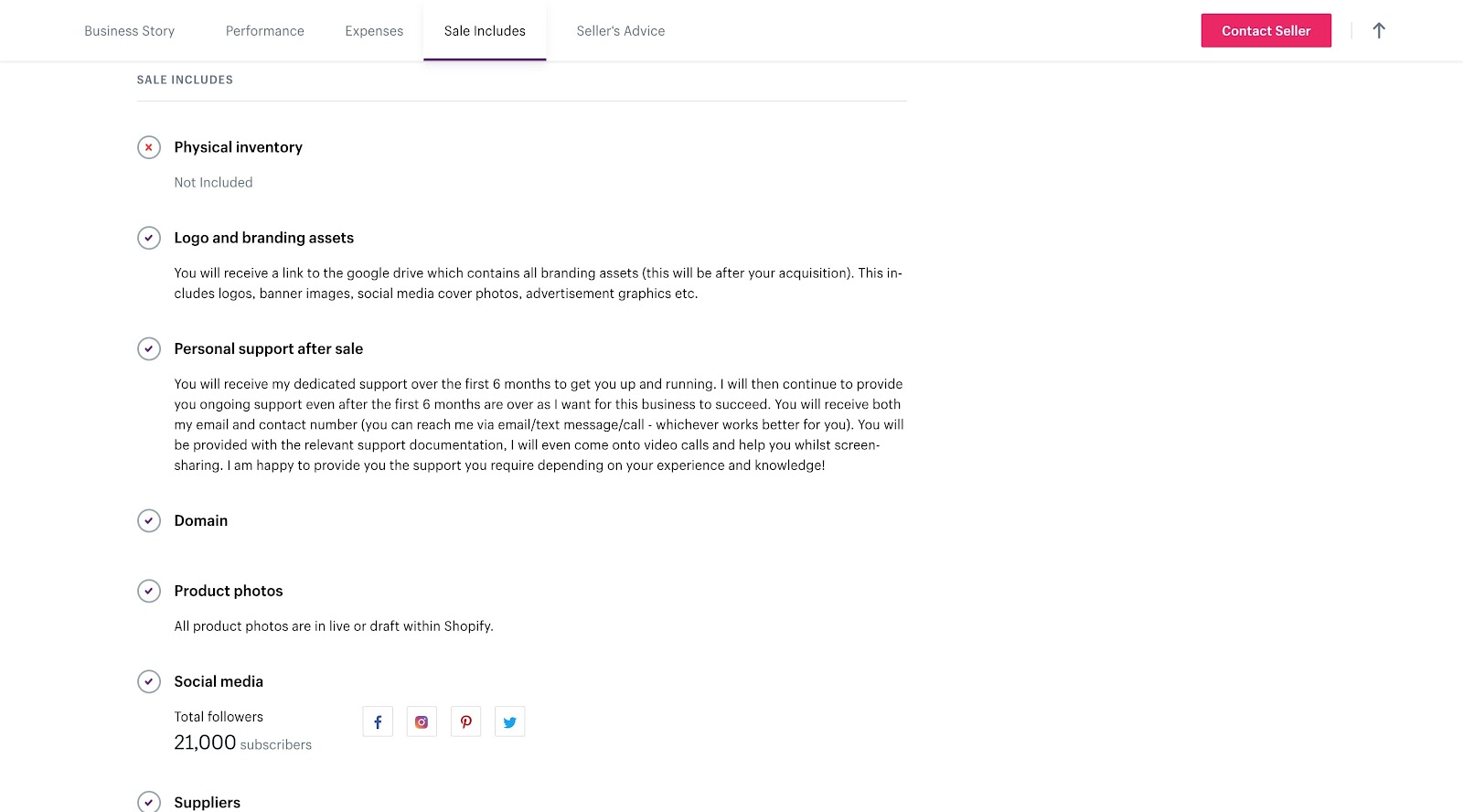
Seller’s Advice
Finally, the seller can include advice to the future store owner.
They are best positioned to know what the store needs for continued success and what the buyer will need to know going into their new venture.
Some sellers will be very helpful, giving detailed suggestions and thoughts (like below), whereas others will say little. This is a good way to assess whether you want to do business with this person or not.
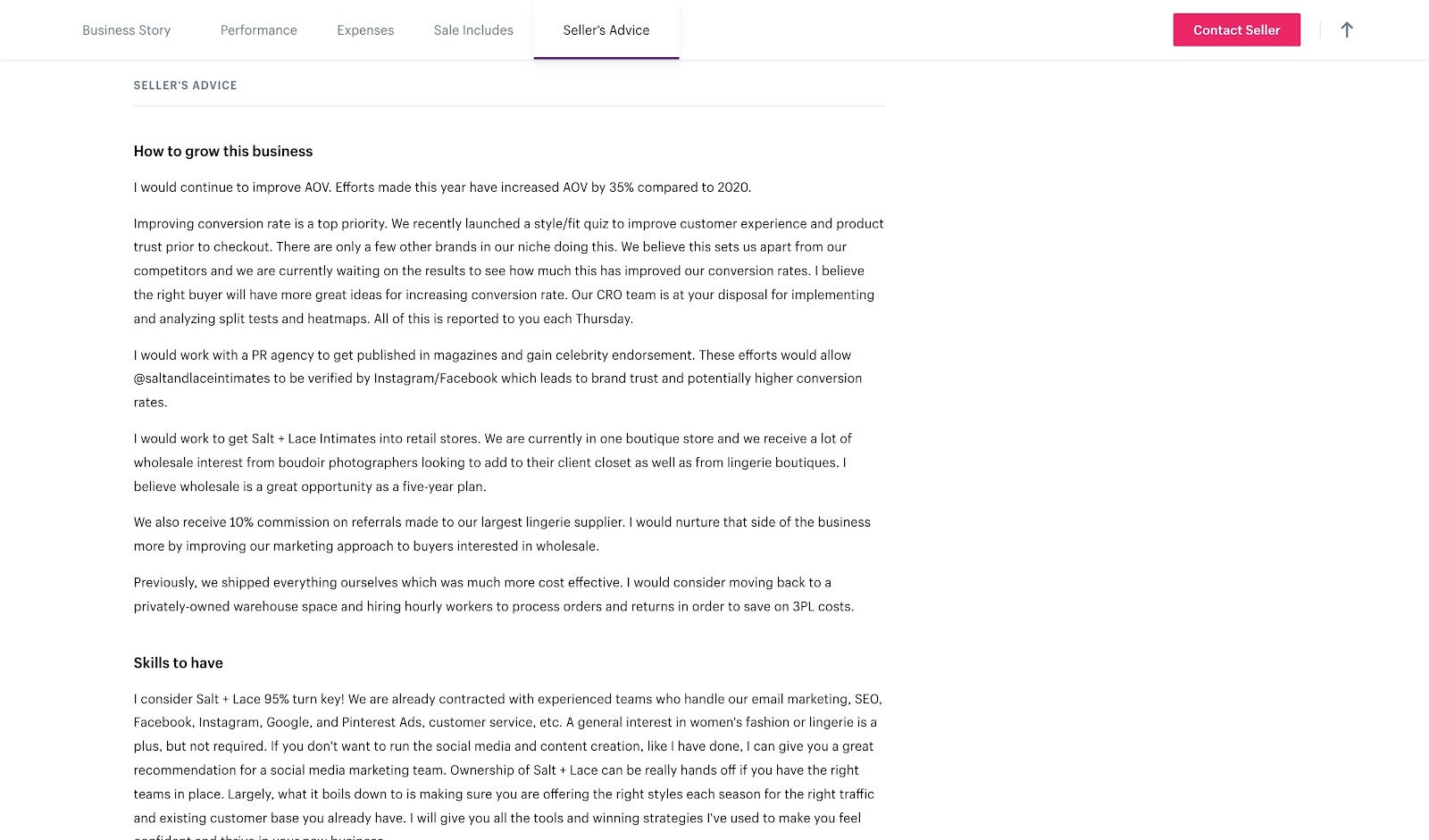
Start building a shortlist of businesses that fit your profile in your trusty notebook. Just your absolute faves.
Now the deeper research begins.
#cta-visual-pb#<cta-title>Increase conversions with custom landing pages<cta-title>Upgrade your new store by building high-converting landing pages with the best page builder for Shopify.Start building for free
Step 3: Compare your top picks
It takes some great decision-making to get to this point. Great work. Now, you have to whittle that list down to just one store.
To do so, you’ll want to dig deeper into each store, noting the best and worst features of each. While the listing includes many details, you’ll want to go beyond the Exchange to learn more about it.
For their socials, look at the number of followers, how often they post, their engagement, etc. This may be a significant channel for driving traffic and sales to the store.
You can also utilize tools like SEMrush and Ahrefs to figure out estimated paid and organic traffic, domain authority, competitors, and SEO opportunities.
They may have other sales channels, too, like Amazon, Walmart, Facebook, etc. You could send a tentative message to them about this and other important extra details about the store’s success.
Once you’ve gone through all the little details, pick your favorite store of the bunch. This is the store you want to buy—say it to yourself to make sure you believe it.
Now, on to the final steps.
Step 4: Send a message to the seller
On the listing for the store, click the Contact Seller button. A modal message window will pop up.
You may want to start the conversation by asking for further details about the store to be totally sure that you want to move forward and that you come with an offer you feel good about.
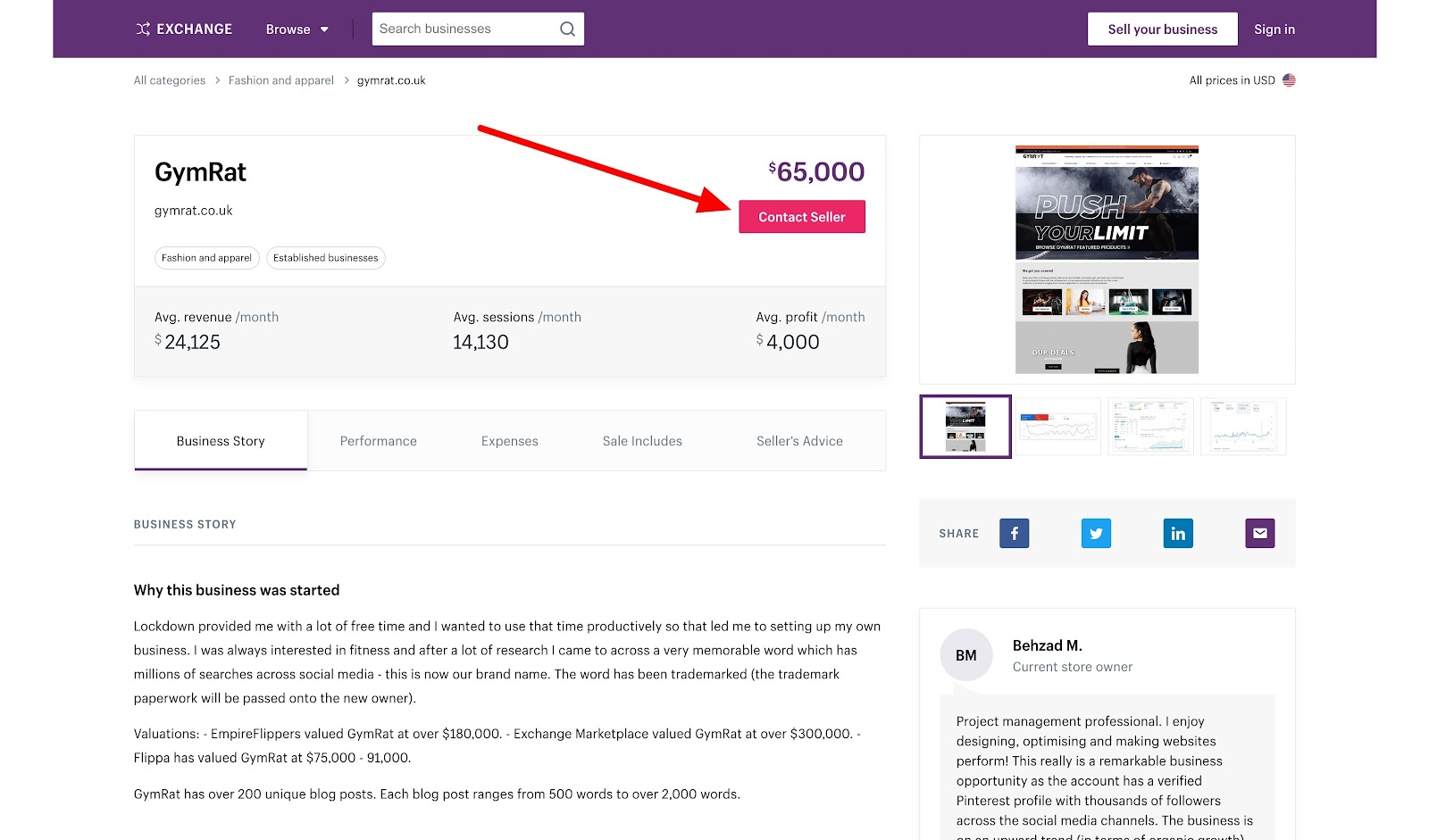
Things to ask about:
- Getting a look under the hood. See if they will share view access to their Google Analytics accounts to verify traffic sources, ad spend, sales, etc.
- Confirmation of financial details. Get information about their actual expenses, their margins, contractors they use, and more.
- What’s included in the sale. While it is in the listing, make sure you completely understand what parts of their business they are including and what is staying with them. This includes inventory, email lists, social media accounts, supplier details, etc.
- The reasons they are selling. The listing may have said a little, but it’s good to ask so you can get any extra information about their exit.
Step 5: Make an offer
After you are satisfied with the deal, you can make an offer.
You don’t have to offer up the listed price, but your offer must be at least 80% of their price. Now, wait for them to accept your offer.
Once they accept your offer, the transaction process will begin.
Step 6: Accept the terms and start the transaction
The seller will detail their terms for the sale, including everything in their listing and everything you agreed upon during the offer conversation, and initiate the transaction.
You’ll receive a notification of these terms and can begin the payment process with the escrow company.
An escrow company is a third party that holds your money for a period of time until both parties are satisfied with the deal.
During this inspection period, you’ll want to make sure that you are getting everything promised, that you can communicate with your new suppliers, and that all accounts are getting transferred to you appropriately.
Once everyone is happy with the deal, the money goes to the seller.
Step 7: Ownership is yours
You’ve bought the store, and now it’s yours. The process of transferring ownership takes a few days.
After you’ve got control, change your passwords and remove the seller’s access to any accounts.
If the seller offered support for a set amount of time, take advantage of that right away to get your new store up and running and earning cash.
You can now make changes to your store, like updating the store name and domain to best reflect your new brand identity.
Congrats—you’ve got a Shopify store!
How to sell your online store on Shopify Exchange
You may find yourself on the other side of the listing someday. Maybe you’ve lost interest in running a store, or a new direction has opened up in your life—it’s time to sell.
If you’ve already bought a store through Shopify Exchange, you’ll have unique insight into what buyers are looking for in a listing.
First thing, you need to see that you are eligible to sell your store. Check their eligibility requirements to make sure you can sell. Mainly, you need to be the site owner, not on a trial period, in good standing with Shopify Payments, and not have a current loan with Shopify Capital.
Secondly, you need to install the Shopify Exchange app on your store.
Finally, you create your listing. Above, we detailed all the sections of a listing and what they mean for buyers. Don’t phone it—spend time adding your details, story, and advice for future store owners.
Eventually, you’ll get that message from a potential buyer asking for more details about your business.
If they are satisfied with everything, they will give you an offer, and you’ll go through the escrow process to part with your store.
With that, you’ve successfully sold your Shopify store.
Customize your new store with Page Builder
Once you’ve bought your new store, you may want to customize it to make the brand more approachable and the pages better at converting.
That’s when you want to find a tool that enables you to quickly and easily customize your store pages.
Something like Shogun Page Builder.
With Page Builder, you can choose from over 30 page elements—such as images, videos, forms, accordions, columns, sliders, countdown timers, and more—to quickly drag and drop together a high-converting landing page.
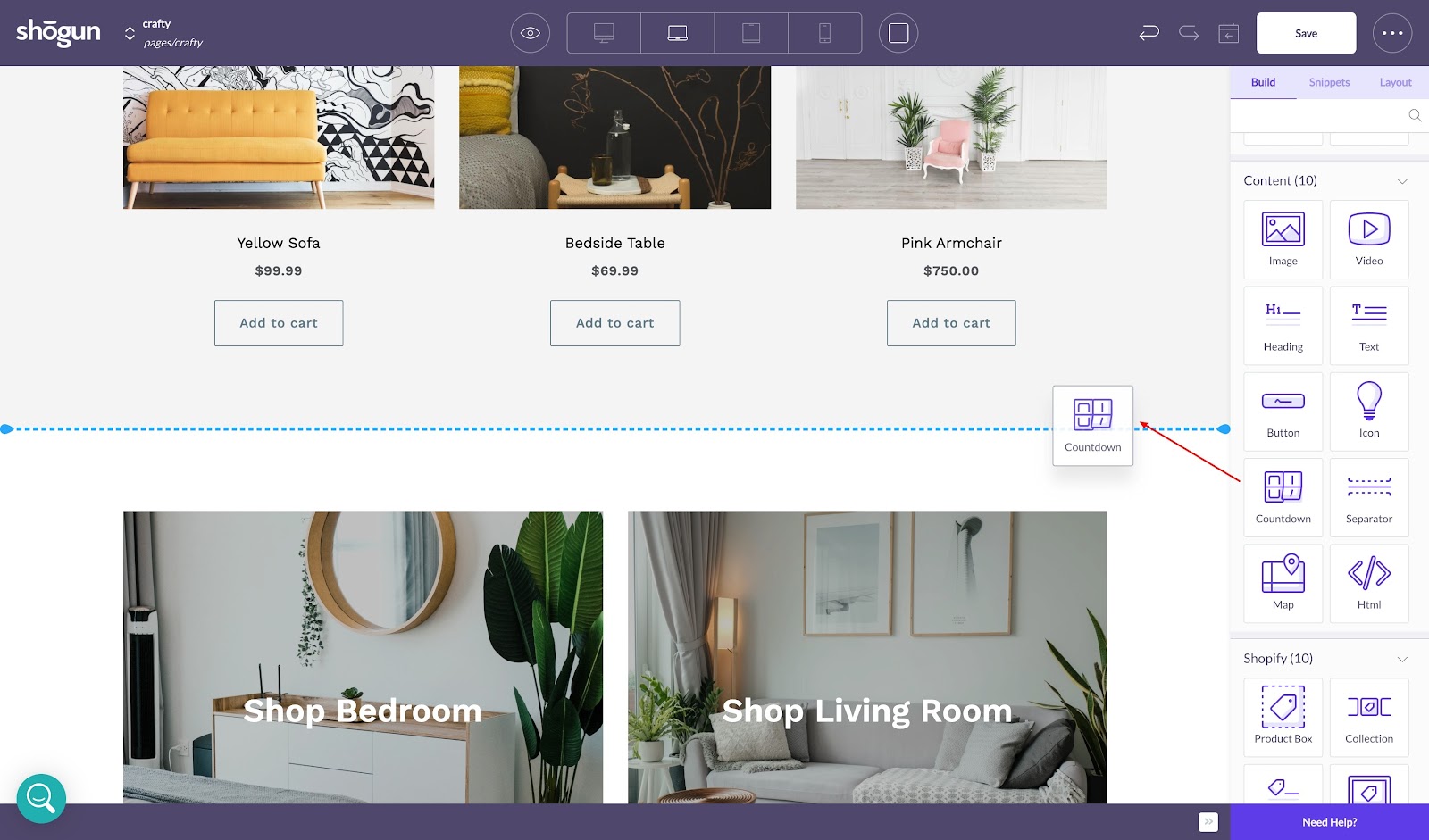
When you’ve taken over an existing store, Page Builder is a quick and easy way to improve your store’s performance.
Jump right into running an online store with Shopify Exchange
When you don’t have it in you to build a store from scratch, it’s great to know that there is another avenue for starting your ecommerce career.
Before you dive into Shopify Exchange head first, you need to figure out what you want from the store you buy. Only when you’ve done the pre-work should you start looking for stores in the marketplace.
Don’t take this shopping trip lightly. It will decide the future of your new endeavor, so get it right.
If you do your research and buy within your means, you can end up with a Shopify store that will start earning for you right out of the gate.
When you decide to optimize for conversions, Shogun Page Builder can take your store pages to the next level.
We’re so excited to see your fancy new store!
#cta-visual-pb#<cta-title>Create your perfect Shopify store today<cta-title>Start building for free with Shogun Page Builder to assemble a fully custom revenue machine.Get started now

Sean Flannigan
Sean is one of Shogun's tireless content marketers. When he isn't creating exciting ecommerce content, he's probably biking or at the park.



